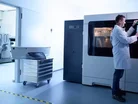Siemens able to customise its production with Stratasys FDM 3D printing

The German manufacturer, Siemens, has seen a rise in customer demand for one-off customised parts.
In order to meet the time and cost barriers of the demand with low-volume manufacturing, Siemens turned to 3D printing.
Through the integration of a Stratasys Fortus 900mc 3D printer, the manufacturer could produce parts of demand.
The additive method is more time and cost effective, benefiting both Siemens and its customers.
“Customizing low-volume production parts using FDM 3D printing has been transformational for our customer service offering, as well as our supply chain,” stated Michael Kuczmik, Head of Additive Manufacturing – Spare Parts at Siemens.
“Not only are we taking orders on-demand, 3D printing has also given us the flexibility to meet customer requirements faster with no obsolete parts created in the process.”
SEE ALSO:
-
US Airforce launches additive manufacturing in supply chain initiative
-
Boeing and Assembrix to partner on additive manufacturing project
-
ARC launch additive biomanufacturing centre at Queensland University of Technology
The manufacturer has found that additive manufacturing has particularly helped within its transport sector in Ulm, Germany.
“Our production services for end-use parts have become much more flexible and tailored to our customers’ needs since we introduced the Fortus 900mc into our manufacturing process,” explained Tina Eufinger, Business Development, SIEMENS Mobility Division.
“Before we integrated 3D printing into production, we were limited to higher quantities of parts in order to make the project cost- effective.”
“For small volume part demands from customers, we would store excess parts until they were used, discarded or became too outdated to use.”
“With the Fortus 900mc, we can now create a design that is 100 percent customized to specific requirements and optimized several times before it is 3D printed.”
“This takes our production time down from weeks to a matter of days, in a way that we can now produce a single customized part cost-effectively in low-volumes.”
